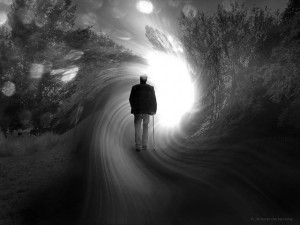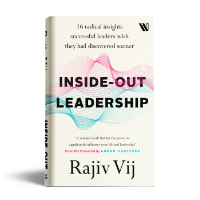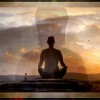
Photo by h.koppdelaney
We live in VUCA, short for Volatile, Uncertain, Complex and Ambiguous, times. Irrespective of our profession or life-cycle stage, VUCA defines our environment. There’s persistent volatility in right from the financial markets to our personal relationships, increased uncertainty of policies, competition and employment in our profession, heightened complexity emanating from the onslaught of globalization and technology in our lives, and amplified ambiguity in the criteria for making numerous life choices.
However, how much we are impacted by VUCA is merely a reflection of our disconnect with our inner self. In our modern society, we have become addicted to looking outside of ourselves for visible measures of success, like the job title, size of the house, and the brand of our car. Additionally, we are caught up in the notion of relative success – obsessed not with how well we are doing, but how we are doing compared to our peers and our social network. Hence, any circumstances that create uncertainty or volatility on these external measures are a source of significant inner turmoil for us.
To better deal with external volatility, we need to build the anchor of greater inner stillness; to gain confidence in an uncertain world, we need to develop deeper self-awareness and strengthen our inner self; to cut through the complexity of our environment, we need to simplify our life by committing our life to a singular meaningful purpose; and to eliminate the ambiguity arising from competing life choices, we need to commit to living a life guided by our personal values and inner yardsticks. That is a real pathway for reinventing ourselves in VUCA times.
Here is a 4-step approach that can help us towards this.
1. Learning to reconnect with our inner self
In our fast paced life, we need to pause by creating time for regular reflection. Creating such quiet moments allows us to connect with our inner values and raise self-awareness at all levels of our being – understanding our physical habits (our priorities, where we spend time and why), emotional triggers (what makes us sad, happy or anxious), mental beliefs (our conditioned attitudes and perceptions) and spiritual identity (who we essentially are beyond the physical form).
Conscious moments of reflection, particularly through some form of meditation, allow us to become aware of our inner source of fear, doubt, anxiety and emotional confusion. Acknowledging and choosing to work on them helps us create inner stillness and steady the inner experience of the perceived external volatility.
2. Examining our limiting beliefs
The reality we experience is a function of our inner beliefs. For example, one conditioned belief we often live with is that the source of our unhappiness is outside of us; we tend to externalize our challenges – my boss is too demanding or my spouse doesn’t care for me any more. The question worth asking yourself is, is your boss too demanding or you not courageous enough to express your needs; has your spouse stopped caring for you or have you stopped demonstrating your love? Which is the truth?
The real change is within us. The good news is that as we work on ourselves and reform our beliefs, irrespective of our environment or the people around us, we start to experience a new reality. It’s the difference between looking outside from the fourth floor of a building and the twenty-fourth – the scenery outside is the same, but we have a very different perspective. Such deepening of our self-awareness helps us build inner strength to weather the external uncertainty.
3. Clarifying a clear purpose of our life
Over the past few decades, we have witnessed significant economic growth, particularly in this part of the world. With that has come enormous choice – for educational courses, careers, entertainment, travel and so forth. While that’s positive for the most part, unfortunately, there seems to be a simultaneous decline in clarity of purpose of our life to be able to make these choices. As a result, our stress levels have grown and the innumerable choices we are faced with leave us perpetually feeling deprived.
I believe each one of us is uniquely gifted and has a special purpose to fulfill on this planet, but do we take the time to discover it within ourselves. What do you want the rest of your life about? What’s that singular pursuit that you would be happy and proud of in your last years, having dedicated a significant chunk of your life towards? Making this purpose the anchor of your life automatically takes away the apparent complexity of our daily lives.
4. Committing to becoming who you are meant to be
Finally, its about converting our intent into actions – taking personal responsibility of our thoughts, feelings and actions. Exercise is a classical example – we are all aware of its need and benefits, but not all of us end up doing it. It’s about committing to reforming our inner selves and living the purpose of our life. Creating a life driven by our personal values and inner yardsticks squarely diminishes the ambiguity arising from the myriad of choices we face.
(This is a slightly edited version of an article I had recently written for the ‘Heal Your Life’ website)











 For Deeper Peace: Reduce Not Negative Thoughts, But Thinking Itself
For Deeper Peace: Reduce Not Negative Thoughts, But Thinking Itself Meditation: An Introduction
Meditation: An Introduction This New Year: Whatever Your Goals, Try Practicing This
This New Year: Whatever Your Goals, Try Practicing This Unlocking Self-Awareness: The Five Levels of Understanding Yourself
Unlocking Self-Awareness: The Five Levels of Understanding Yourself Personal Mastery and Leadership
Personal Mastery and Leadership
In such a journey, patience is key. VUCA antidote of the type mentioned by Rajiv can be summarized in 4 steps – 1. Start meditation (or better still, yoga) 2. Establish the goal “I am a ..” and repeat the same daily. 3. Set timelines and actions 4. Always plan and act, minimize worry and reaction.
Greater inner stillness with singular meaningful purpose – it surely requires a good homework, meditation and study of of self inside us. Above all, it requires commitment to do this as well – specially when, everything else is too challenging and important. Hence, having a mindset to reform inner self based on personal values & yardstick is very important. We may need to forego a few other tasks which we wrongly feel as our “Priority”.